Dzükou Valley Trek: Your Ultimate Guide To India’s Famous Hike
By Joydeep Phukan. This guide to Dzukou Valley trekking contains affiliate links to trusted partners!
Interested in doing the Dzükou Valley Trek?
Then you’re in the right place!
You’ve likely heard of the famous hikes in India’s Himalayan region; but, have you heard of the Dzükou Valley Trek in Northeast India?
Sitting in the clouds at an altitude of 2,452 meters (8,000 feet) above sea level, the Dzükou Valley — also written as Dzukou Valley or Dziiko Valley — is located in the Indian state of Nagaland.
The administrative border between the states of Nagaland and Manipur passes through the valley; however, Dzükou Valley is only accessible from the Nagaland side.
Inhabited by 16 major ethnic groups and sub-groups, Nagaland is blessed with cultural diversity, mountains, and natural beauty, which is best explored by doing the popular Dzükou Valley Trek.
Interesting fact:
The term “Dzüko” is derived from the local Viswema dialect of the Angami Nagas and means “dull and soulless” — though don’t let this deter you from visiting for a hike. The name was given because the ancestors of Viswema village couldn’t cultivate crops or establish a settlement in the valley.
They were, however, still able to appreciate its extreme beauty. Dzükou Valley is covered in dwarf bamboo shrubs, with high hills surrounding uniform hillocks and a tranquil river flowing through the valley. Moreover, the views you’ll enjoy while hiking are truly spectacular.
What Type Of Hiker Are You? [Free Quiz]
Now, before we dive further into how to hike the Dzükou Valley, I want to share a free personality quiz I think you’ll love!
Discover your hiking persona in this fun and short hiker personality quiz, which also shares trail suggestions based on your results.
Once you’ve grabbed the quiz, keep reading for an in-depth Dzukou Valley Trek Guide. This stunning hike is a must-do for outdoor enthusiasts visiting India!
Dzükou Valley Trekking Map
Before hiking in the Dzükou Valley, it’s recommended to check out a map to get a lay of the land.
The below Dzükou Valley map offers a great starting point, or you can click here for the interactive Google Maps version.
Best Time To Do The Dzükou Valley Trek
In terms of the best month to visit Dzukou Valley, it’s truly a year-round destination.
In fact, monsoon season — May to August — is when the vibrant pink Dzükou Lily blooms. This flower is very special, as it can only be found in the Dzükou Valley. As it grows alongside other colorful flowers against lush green grasses, it creates a truly stunning scene.
On the other hand, during winter, the Dzükou Valley is covered by frost and receives snowfall, particularly towards the end of December until February. As long as you don’t mind the cold, this can be a lovely time to visit as you can take in frozen views of the valley.
How To Reach Dzukou Valley (Getting There)
The Dzükou Valley can be reached via two hiking trails; one from the Viswema Village and the other from Jakhama (also spelled Zakhama).
Hikers generally go through Viswema, as the Jakhama trail is much steeper. In fact, Viswema only has about one hour of uphill hiking vs Jakhama, which is a steep ascent almost the entire way. Remember, you can always go up the Viswema trail and down the Jakhama trail.
Viswema Village is about 14 miles (22 kilometers) and Jakhama is about 9 miles (15 kilometers) from Nagaland’s capital city of Kohima.
To reach Kohima, private cars, taxis, sumos (shared taxis), and buses regularly drive from Dimapur, which is home to the nearest regional airport. LGBI Airport in Guwahati (Assam) is the nearest International Airport.
By railway, the Dimapur Railway Station is well connected to other states. You can head to Kohima from the station by boarding public buses, private cars, and sumos. It takes around 2-2.5 hours to reach Kohima from Dimapur.
From Kohima, you can take a shared taxi from the Networks Travel AOS Bus Stop to reach either Viswema or Jakhama.
Important note:
Indian nationals must get an Inner Line Permit (ILP) to visit Nagaland. For foreign visitors, passports and visas are enough for entering Nagaland; however, they sometimes ask foreign tourists to register themselves at the nearest local police station upon their arrival to the state.
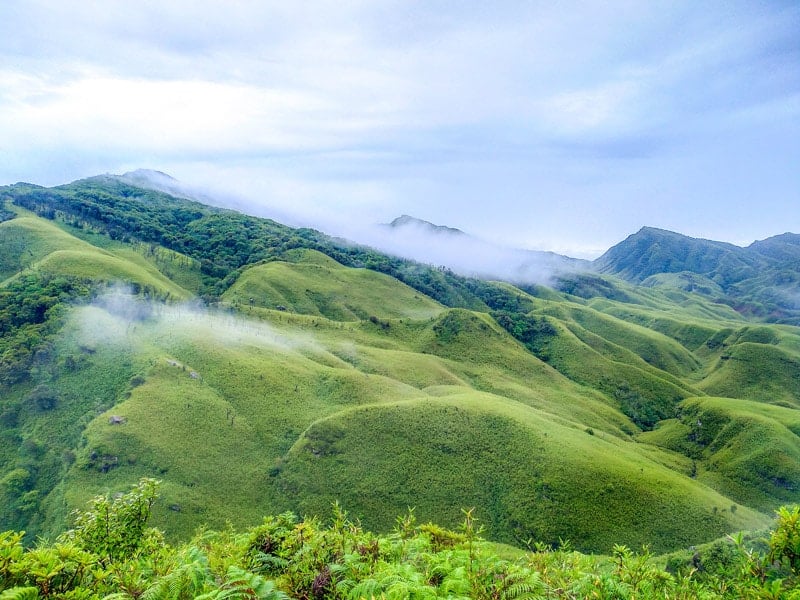
The Dzükou Valley Trek– Essential Information
Dzükou Valley Elevation: 2,452 meters (8,000 feet) above sea level.
Dzükou Valley Trek Elevation Gain: Viswema is 1,631 meters (5,351 feet) above sea level and Jakhama sits at 1,606 meters (5,269 feet). This means a hiker would gain about 821 meters (2,694 feet) when hiking from Viswema and about 846 meters (2,776 feet) when hiking from Jakhama.
Dzükou Valley Trek Difficulty: Moderate (from Viswema) and difficult (from Jakhama).
Dzükou Valley Trek Duration: The minimum time to reach the Dzukou Valley Guest House — which is the end point of the trek — is about 4-to-5 hours from both villages. The Dzukou Valley Trek distance distance via Viswema is approximately 13 kilometers (8 miles) and 10 kilometers (6 miles) via the Jakhama trail.
Dzükou Valley Trek Location: Kohima District, Nagaland.
Dzükou Valley Trek Trailhead: The best part of hiking to Dzukou Valley is plenty of signage along the way!
- The trailhead at Jakhama starts from the main road near a bridge by the river — a little ahead of the sumo stand of Jakhama. Click here for a Google map.
- At Viswema, the hiker has to first reach the “Trekker’s Point”, which is about 8-9 kilometers (5-5.6 miles) from the village. The actual trail starts from the Trekker’s Point. Click here for a Google map.
Other Nearby Hikes: When in Nagaland, also don’t miss Mt. Saramati and the Japfu Peak Trek.
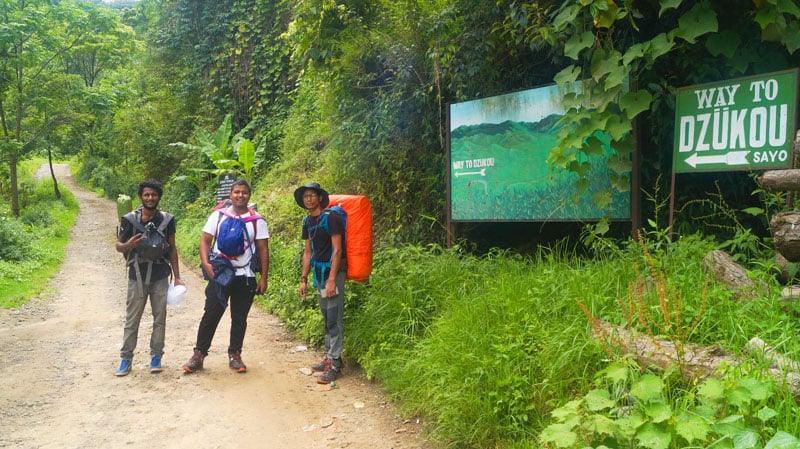
Dzükou Valley Trek Step-By-Step Guide
Ready to embark on one of the world’s best hikes? Let’s do this!
Dzükou Valley Trek via Viswema
From Viswema, one can walk 8 kilometers (5 miles) along drivable road or hire a taxi outside the village gate for about 1000-1500 INR (~$14-$20 USD). While walking can save you money, it also expends quite a lot of energy and adds about 2-3 hours to your hiking time.
Once the road ends, you’ll reach the “Trekker’s Point” — which is when it’s time to hike.
The trek begins with a steep 4-kilometer (2.5-mile) climb up rough-hewn stone steps through forest. This section takes about 45 minutes to an hour.
Note that depending on the weather, this section can be muddy and slippery, so make sure you bring the proper hiking attire.
Keep trekking until you reach the top of Viswema Hill, which is when you officially reach the Dzükou Valley. Spend some time here admiring the breathtaking views over the valley.
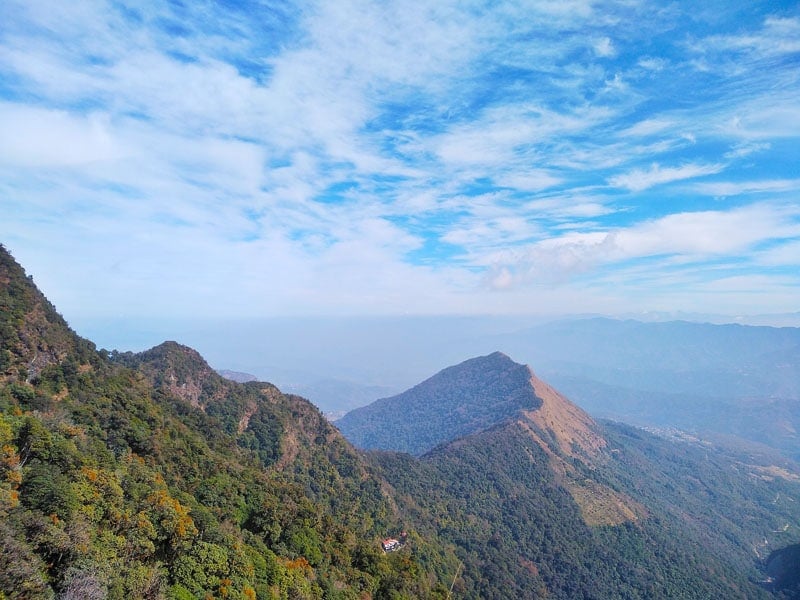
Along with being beautiful, this is also where the steep section ends and where you’ll be faced with two trails. The one to the left goes to Mt. Tempfu, while the trail to the right leads you to deeper into the Dzükou Valley.
Head right and enjoy the scenery, as the rest of the trail — which is another 4 kilometers (2.5 miles) — is relatively flat. You’ll zig-zag along the valley slope and cross lovely little streams until you reach the Dzukou Valley Guest House.
Dzükou Valley Trek via Jakhama
Your other option is to hike from Jakhama, which is the more demanding of the two options, but it takes less time. Also note that during monsoon season, this trail may be extra slippery, so make sure to have proper footwear.
The trail begins at the bridge near the main road of Jakhama village.
Personally, I hiked right from the sumo transport stand in Jakhama. From the sumo stand, you can ask the driver to drop you 4 kilometers (~2.5 miles) ahead at the small rest house constructed by the Kohima Forest Division.
Hiking a little ahead, you will see local farms and farmer huts, which is where the road ends. From here, you’ll cross another river and begin the super steep trail through dense forest.
It is a painful straight ascent, with stone steps bringing you higher and higher until you reach the top of Jakhama Hill, which takes about 3-4 hours.
From here, you can enjoy a lovely view of the Dzükou Valley, the Viswema Trail, and the Watch Tower of the valley. The Watch Tower is of particular note, as it offers a true panoramic view of the Dzükou Valley and the villages below. It can accessed from near the Dzukou Valley Guest House.
After descending the hill, the Viswema Trail and Jakhama Trail merge. Turn right and you will immediately be able to see the Dzukou Valley Guest House. It is a flat stretch of just 2 kilometers (1.2 miles) to the accommodation.
Staying At The Dzukou Valley Guest House
The Southern Angami Youth Association (SAYO) maintains the Dzukou Valley Guest House.
There are two houses, which they refer to as dormitories. One has a wooden floor while the other is concrete. Hikers sleep on the floor in these dorms, and the guest house caretakers provide blankets, mats, and other sleeping accessories.
Once you reach the guest house, you will need to pay an entrance fee for hiking the Dzükou Valley as well as for accommodation, meals, and sleeping accessories.
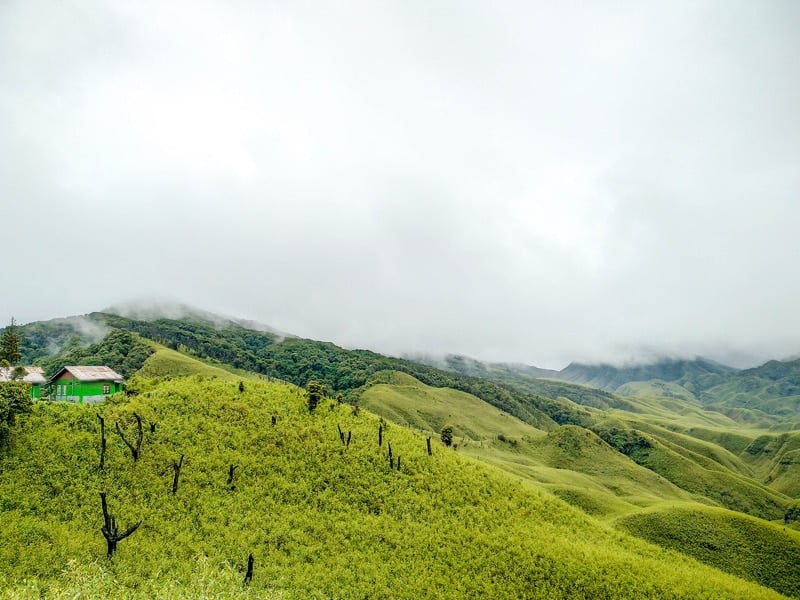
The guest house kitchen offers both vegetarian and non-vegetarian meals once a day. You can eat noodles (non-vegetarian) on other occasions.
A makeshift kitchen can also be rented if you want to cook for yourself, though you’ll need to buy firewood and rent utensils from the guest house.
There is also a small shopping stall at the campsite offering sweets, biscuits, and noodles, among other things.
A toilet/bathroom is available for public use.
SAYO also offers a cottage secluded from the main campsite area. It costs more than the dorms but has an attached bathroom.
Moreover, there is a campsite with space for pitching your own tent or you can rent a tent from the guest house.
In the summer months, water is readily available at the campsite in a reservoir connected to the stream. In winters, however, you have to collect water from a stream about 5 minutes away from the campsite for drinking and flushing the toilet.
Dzükou Valley Trekking Tips
Now that you know what hiking the Dzükou Valley is like, let’s go over some essential tips. The below advice will really help you have the best Dzukou Valley trip possible.
-Most people hike the whole day and stay at the guest house for only a night; however, to really experience the serene beauty of the valley, I would suggest you to stay at least 2-3 days. You may hike down into Dzükou Valley, visit the Watch Tower for a panoramic view, and swim in a river. Furthermore, you can hire a local guide to take you to lesser-known caves, natural pools, and waterfalls.
-Since there are two trail options, why not do both? Many people opt to hike the easier trail from Viswema to get to the guest house and then return via the steep Jakhama route, which is much easier on the way down, especially with its stone steps.
-Riverside camping has been banned due to littering. Therefore, the Dzukou Valley Guest House is where you can stay in the valley.
-There is no electricity in the valley, so make sure to carry a power bank and headlamp. Moreover, charge your phone and camera battery fully before setting off on the Dzükou Valley Trek.
–Traveling solo? You can totally do the Dzükou Valley Trek on your own! Plus, the Dzükou Valley is an incredible destination for solo female travel in India. That being said, a local guide will help you from getting lost, can enlighten you about local Naga traditions, and can share interesting folklore stories associated with the valley. Bonus: by hiring a local guide, you’re supporting the local economy.
-You won’t find any shops for snacks or eateries along the trail. Though you will find a few streams for collecting clean drinking water, it is always advisable to carry a good amount of drinking water and dry fruits to eat during the hike.
-Since the trek time is about 4-5 hours from either of the villages, it is suggested that you start early in the morning. Arriving to the guest house in the evening can sometimes mean there aren’t any rooms or campsite spots left.
-While blankets are available at the guest house, if possible, it’s wise to bring a high-quality sleeping bag and accessories. This is especially true during the cold winter months.
-There is no network connectivity in the Dzükou Valley. If you want to call your loved ones, you have to climb to the peak of the hill where the Watch Tower is.
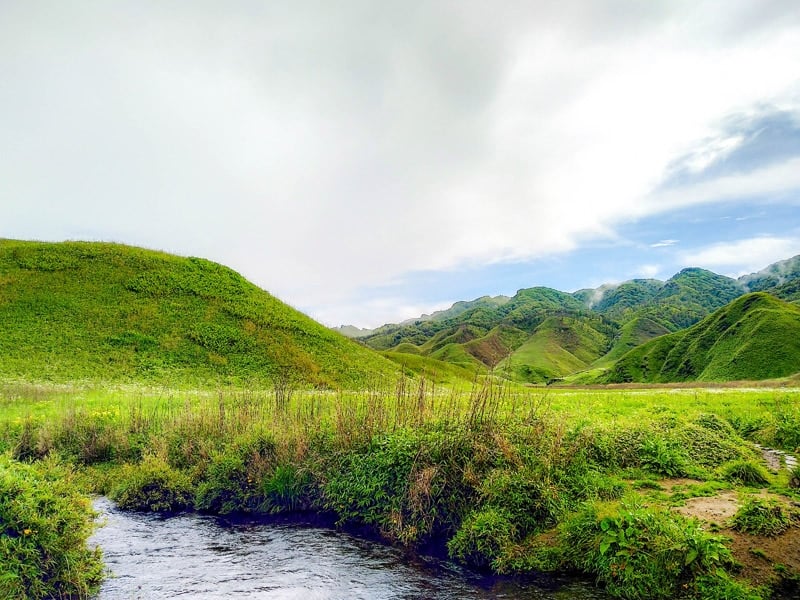
What To Pack For The Dzükou Valley Trek
If you are visiting the Dzükou Valley during monsoon season in the summer, there is a higher chance of rain. Therefore, a poncho or raincoat and rain cover (for your backpack) is a must.
You must also wear shoes with good grips, as the trails become slippery.
As far as clothing is concerned, hikers should bring a lightweight jacket, thermals, stretchable hiking pants, t-shirts, socks, and gloves. Bring an extra set of clothes if you plan to spend time swimming.
Wearing sweatshirts or T-shirts during the day is sufficient, but it gets very cold at night.
Moreover, during winter, it’s extra important to carry a quality sleeping bag. You’ll also want to bring some extra layers and potentially an extra jacket for additional insulation.
You can purchase all of your hiking clothing and camping gear at REI here.
Dzükou Valley Trek Cost
In terms of the Dzukou Valley trip cost, registration for the hike costs 100 INR (~$1.34 USD), while accommodation costs:
- 1500 INR (~$20.15 USD) for a room in the cottage with attached bathroom
- 100 INR (~$1.34) for a dormitory space or campsite
Now, if you’re curious what the approximate costs are for your entire round-trip from Guwahati in Assam (where the international airport is located), you’ll likely spend about 4,000 INR to 6,000 INR (~$54-$81 USD). This includes trains, transport, accommodation, food, and guide.
Travel Insurance For Your Dzukou Valley Trip
When visiting India — or anywhere else in the world — it’s wise to get travel insurance.
One of the best travel medical insurance for travelers is SafetyWing as they’ve got a large network and offer both short-term and long-term coverage — including coverage if you’re traveling for months as well as limited coverage in your home country).
Additionally, SafetyWing is budget-friendly and offers $250,000 worth of coverage with just one low overall deductible of $250.
Click here to price out travel insurance for your trip in just a few clicks.
Have you ever done the Dzükou Valley Trek?
About The Author
Joydeep Phukan is the founder of the blog The Gypsy Chiring. He shares his stories and tips on travel, adventure, food, and culture from places around the world — but primarily covers Northeast India. He intends to promote the lesser-known cultures and offbeat destinations of Northeast India. Connect with him on Instagram, Facebook, Twitter, and Pinterest to explore Northeast India together.
Enjoyed this Dzukou Valley Trek blog post? Pin it for later!

Hi, I’m Jessie on a journey!
I'm a conscious solo traveler on a mission to take you beyond the guidebook to inspire you to live your best life through travel. Come join me!

Want to live your best life through travel?
Subscribe for FREE access to my library of fun blogging worksheets and learn how to get paid to travel more!

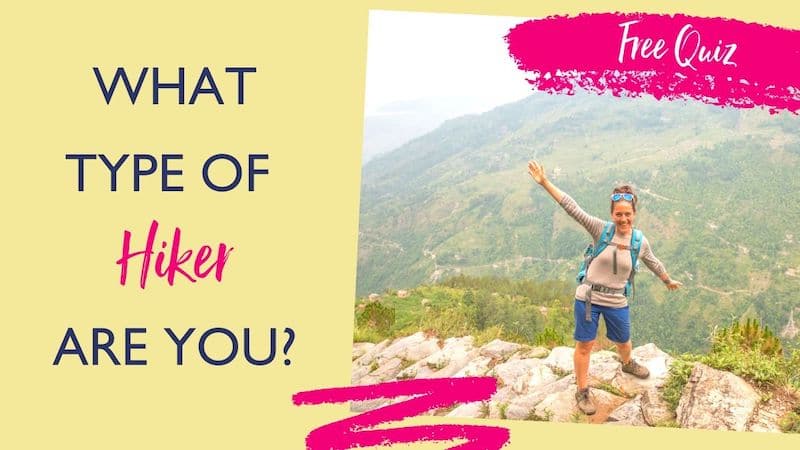


Hello there, I just wanna ask about hiring a taxi to reach the trekker’s point. It cost 1500 INR for the taxi. Is that for the round trip or do we have to pay another 1500 INR to reach the Viswema village gate from the Trekker’s piont. IF its for the round trip, then does the taxi wait or do we call for it to pick us up.
Answering this would be very helpful.
Thank you.
It’s not a round trip. You have to pay again. The fare has recently been increased too. It is 2200 INR just for taking you up till the trekker’s point. And yes , you have to call the driver once you get network near at the top of the Viswema hill or a little below. The alternate choice is to hike right from the main road via Viswema or trek through the Jakhama trail.
Thank you….. you have been very helpful. I just needed this information to complete my plans. Thank you again.
Great article. I think a lot of it can be summed up by the simple rule of respect for persons and respect for land i.e treating others as you would like to be treated…this usually works for me. Obviously that’s oversimplifying it a bit… 🙂
Idk why I’m googling Dzukou Valley today but I got nostalgic… back when I visited Nagaland in 2015 there was little to no information about the region online 😀 it’s cool to see more now.
I visited a friend (made unexpectedly over a facebook bug lol) in Chedema Village and we made a 3day trek to Dzukou (took the Jakhama route and itttt was toughhhh). It was mid August and it was super weird but we got nice weather until we were almost completely descended. Sad to hear the riverside camping is forbidden now, it was nice to sleep under the slanted rock outside 😀 but littering is a big problem and was really sad to see all over the region.
I was barely 18 and never had travelled out of europe so arriving in New Delhi and taking a 36hr train to Dimapur was a huge culture shock xD but reaching the mountain village was such a relief. The Naga people in the village were so welcoming and curious.. I really loved staying there 🙂
..uhh yea so thanks for helping me indulge in reminiscences ~
Yay! Glad to know that the article helped you reminisce your beautiful memories of Dzukou Valley. It would be great to meet you in person. Do plan again, I would be happy to help. Are you aware of the Hornbill Festival of Nagaland? Here, all the 16 major Naga ethnic groups showcase their culture. You would love to attend it. It is conducted every year from December 1st to December 10th.